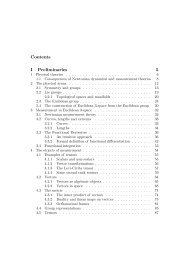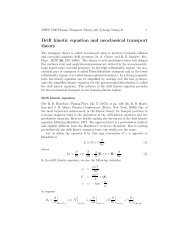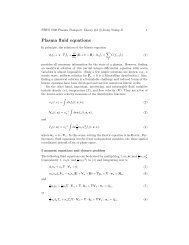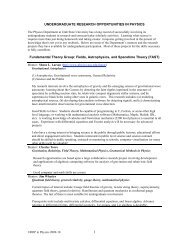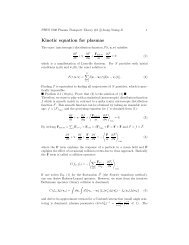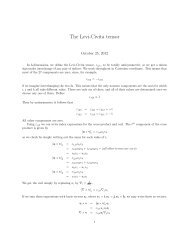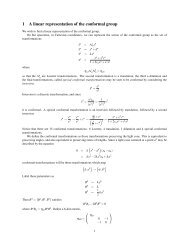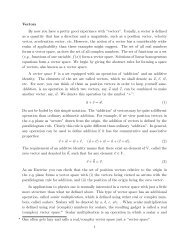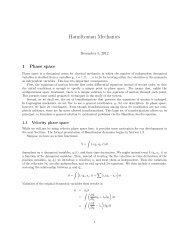Wheeler, Mechanics
Wheeler, Mechanics
Wheeler, Mechanics
Create successful ePaper yourself
Turn your PDF publications into a flip-book with our unique Google optimized e-Paper software.
2.4 Functional integration<br />
It is also possible to integrate functionals. Since a functional has an entire function as its argument, the<br />
functional integral is a sum over all functions in some well-defined function space. Such a sum is horribly<br />
uncountable, but it is still possible to perform some functional integrals exactly by taking the infinite limit<br />
of the product of finitely many normal integrals. For more difficult functional integrals, there are many<br />
approximation methods. Since functional integrals have not apppeared widely in classical mechanics, we do<br />
not treat them further here. However, they do provide one approach to quantum mechanics, and play an<br />
important role in quantum field theory.<br />
3 Physical theories<br />
Within any theory of matter and motion we may distinguish two conceptually different features: dynamical<br />
laws and measurement theory. We discuss each in turn.<br />
By dynamical laws, we mean the description of various motions of objects, both singly and in combination.<br />
The central feature of our description is generally some set of dynamical equations. In classical mechanics,<br />
the dynamical equation is Newton’s second law,<br />
F = m dv<br />
dt<br />
or its relativistic generalization, while in classical electrodynamics two of the Maxwell equations serve the<br />
same function:<br />
1 dE<br />
c dt − ∇ × B = 0<br />
1 dB<br />
c dt + ∇ × E = 4π c J<br />
The remaining two Maxwell equations may be regarded as constraints on the initial field configuration. In<br />
general relativity the Einstein equation gives the time evolution of the metric. Finally, in quantum mechanics<br />
the dynamical law is the Schrödinger equation<br />
Ĥψ = i ∂ψ<br />
∂t<br />
which governs the time evolution of the wave function, ψ.<br />
Several important features are implicit in these descriptions. Of course there are different objects –<br />
particles, fields or probability amplitudes – that must be specified. But perhaps the most important feature<br />
is the existence of some arena within which the motion occurs. In Newtonian mechanics the arena is Euclidean<br />
3-space, and the motion is assumed to be parameterized by universal time. Relativity modified this to a<br />
4 -dimensional spacetime, which in general relativity becomes a curved Riemannian manifold. In quantum<br />
mechanics the arena is phase space, comprised of both position and momentum variables, and again having<br />
a universal time. Given this diverse collection of spaces for dynamical laws, you may well ask if there is any<br />
principle that determines a preferred space. As we shall see, the answer is a qualified yes. It turns out that<br />
symmetry gives us an important guide to choosing the dynamical arena.<br />
A measurement theory is what establishes the correspondence between calculations and measurable numbers.<br />
For example, in Newtonian mechanics the primary dynamical variable for a particle is the position<br />
vector, x. While the dynamical law predicts this vector as a function of time, we never measure a vector<br />
directly. In order to extract measurable magnitudes we use the Euclidean inner product,<br />
〈u, v〉 = u · v<br />
34



